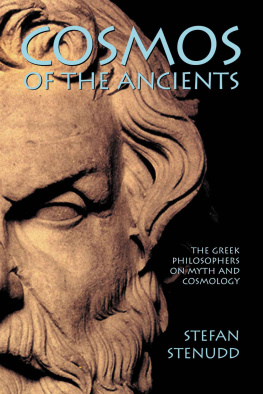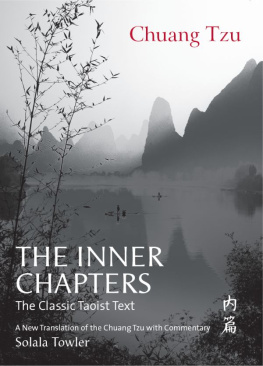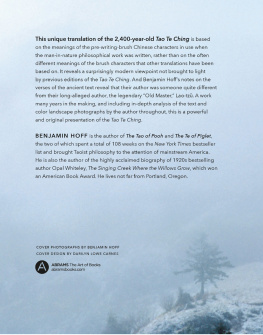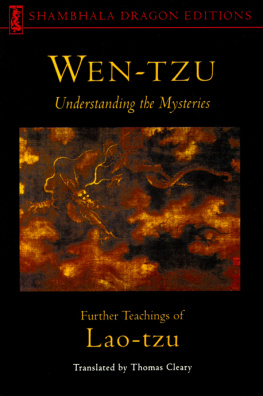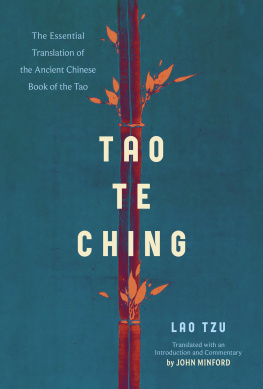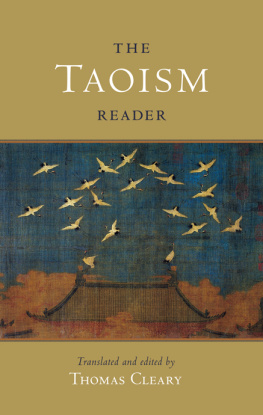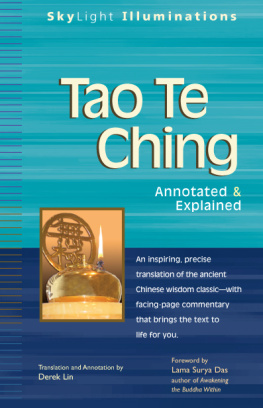Tao Te Ching
The Taoism of Lao Tzu Explained

Stefan Stenudd
Stefan Stenudd is a Swedish author, artist, and historian of ideas. He has published a number of books in Swedish as well as English, both fiction and non-fiction. Among the latter are books about Taoism, the cosmology of the Greek philosophers, the Japanese martial arts, life force concepts, and astrology.
In the history of ideas he studies the thought patterns of creation myths, but also Aristotles Poetics . He is an aikido instructor, 7 dan Aikikai Shihan, former Vice Chairman of the International Aikido Federation, member of the Swedish Aikido Grading Committee, and President of the Swedish Budo & Martial Arts Federation. He has his own extensive website:
www.stenudd.com
Also by Stefan Stenudd:
Tao Te Ching: The Taoism of Lao Tzu Explained, 2011.
Tao Quotes, 2013.
Cosmos of the Ancients: The Greek Philosophers on Myth and Cosmology, 2007.
Life Energy Encyclopedia, 2009.
Qi: Increase Your Life Energy, 2008.
Aikido Principles, 2008.
Attacks in Aikido, 2008.
Aikibatto: Sword Exercises for Aikido Students, 2007.
Tarot Unfolded, 2012.
Your Health in Your Horoscope, 2009.
Alls End, 2007.
Murder, 2006.
Stefan Stenudds Taoism Website:
www.taoistic.com
Tao Te Ching: The Taoism of Lao Tzu Explained.
Stefan Stenudd 2011, 2015.
Book design by the author.
All rights reserved.
ISBN: 978-91-7894-039-4 (for the printed book)
Publisher: Arriba, Malm, Sweden, info@arriba.se
www.arriba.se

Lao Tzu, legendary writer of the Tao Te Ching, leaves China on a water buffalo. Chinese bronze figure from the 17 th century.
Table of Contents

Ta Chi, the Supreme Origin. Symbol of the foundation of the world. It is most often represented by the well-known yin and yang symbol. Chinese illustration from the 18 th century.
Preface
My first meeting with the Tao Te Ching was in my late teens. It was Toshikazu Ichimura, my Japanese teacher of the peaceful martial art aikido, who gave me a copy of it the Gia-Fu Feng and Jane English version with beautiful calligraphy, which is still in print. He thought that my impatiently inquisitive mind would benefit from studying it.
Already by reading the first chapter, which compares desire and the freedom from desire without seeming judgmental, I was hooked. That appeals to a teenager.
The book remained with me, far beyond my teen years. It spoke of so many other things that I found relevant. Contrary to most reading experiences of my youth, I found Lao Tzus work to increase its relevance, as if written in a future that we still have not reached. That alone is an enigma making it impossible to let the book gather dust in the shelf. It contains many others.
Tao Te Ching , which is the major source of Taoism, has a clouded origin. It was composed no earlier than the 6 th and no later than the 4 th century BC. According to legend, its writer was Lao Tzu, a high official of the Chinese empire, who left his work and his country in dismay, fed up with the charade of government.
He is said to have departed riding on a water buffalo. A border guard, impressed by his wisdom, pleaded him to write down his thoughts before leaving China. So he did. Then he crossed the border, never to be seen again.
His text is around five thousand words long, divided into two parts. One of them begins with the word Tao , the Way, the other with the word Te , virtue. The Tao Te Ching , the Book on the Way and Virtue, is a text as difficult to interpret as its origin is to ascertain. It speaks with simple directness, but conveys ideas so elusive that they have been discussed for over two thousand years, without any consensus reached as to their meaning.
Although clear about presenting a worldview and arguing for it, the book is written with the elegance and artistry that makes it most appropriate to call it a poem. Also, most of it is rhymed. Thats not very difficult with Chinese rules for rhyme, but it still indicates that the author intended more than to pursue a line of reasoning.
Probably, the subtleties included were only possible to put into words with the added sophistication of poetry. What was to be said needed an artistic approach, just like some complex truths about the conditions of life need fiction to be pointed out.
To be understood at all, the text needs to be contemplated and interpreted by several minds. This has indeed been done, through the centuries, and that process is not at all slowing down.
Tao Te Ching has had countless Chinese commentaries through its circa 2,500 years of existence. The text reached the West rather late, but weve more than made up for that by an accelerating number of Western translations in the last hundred years. They keep coming.
Thats necessary. The text is far too vague and unclear to be trusted to just one translation. There must be several perspectives in which to see it and several shapes in which to form its wordings in English and other languages.
No doubt, although the text has been kept faithfully intact through all this time, each generation needs its renewed interpretations in order to approach it and grasp its subtle meaning.
Thats true for any classic. In a constantly changing world, its necessary to reinterpret the classics in order to have a chance of grasping them. That way, we may even succeed to reveal new things about them, and come closer to a definitive understanding of them. Even if we dont, its by reexamination that we keep them alive and carry them with us into the future. The words of Lao Tzu definitely belong to those that deserve our continued attention and preservation.
So, here is my version of the Tao Te Ching .
Almost twenty years ago, I made a Swedish translation of Lao Tzus text, the first edition of which was published in 1992. Actually, the project started with another goal in mind.
In the 1980s, I was writing a novel and got the idea to begin each chapter with a quote from the Tao Te Ching . That would fit my story in an intriguing way. But the few existing Swedish versions of the Chinese classic didnt appeal to me as much as the English versions I had come across. After some struggle, I came to the conclusion that I needed to make my own translations of the quotes I wanted to use.
The job was mesmerizing, so I found myself translating the whole book. I was still in doubt about it, until a prominent Chinese poet, Li Li, who lives in Sweden, agreed to proof read. He approved of my version, with some kind words about it that made me confident enough to have it published. My novel was published later the same year.
Since then, I have reexamined and reworked my Swedish version of the Tao Te Ching in several editions. It has become an obsession.
For this English edition, though, I started all over. I wanted to avoid following old trains of thought and any preconceptions. The translation into another language needed a fresh approach.
Sure enough, it made me discover new things about the text and coming to new conclusions about its content. So, for me it was again a wonderful journey. I hope the reader will share some of my delight.
In this version, I have returned to a very old tradition in dealing with the classics, practiced in the East as well as in the West. I let each chapter be followed by my comments about it. That way, the reader will have me as a close companion all through the Tao Te Ching . Those who prefer to do the voyage through Lao Tzus words all by themselves can simply skip my comments and go directly from chapter to chapter of the translated text.
Next page

